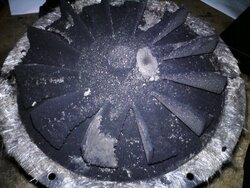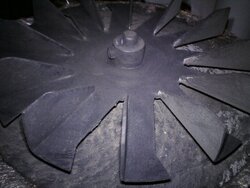I’ve had my Quest Plus for about 10 years and have never had a problem with it (I don’t run it 24/7).
It gets a daily cleaning (the business end), brushed out, glass cleaned, burn pot cleaned out and ash brushed to the ash drawer, other than that no maintenance to the innards. About four years ago I decided it was time to have the professionals come in to do a through cleaning. So much for maintenance.
After reading the forum where everyone seems to do their own deep cleaning I decided this morning to check out a few things. The stove has been down for a day since the temp yesterday was 50° so it was cold enough to work on.
I took the back off to check the blowers and generally looked it over. One I could see the squirrel cage and was delighted to see it was only slightly dusty, no dust bunnies or clogging. Tow, the other one, the exhaust blower must be removed to be able to see the innards, so that will have to wait until spring.
I have been concerned with the damper as it didn’t seem to close all the way (I realize that wouldn’t be such a good idea) because when originally adjusted the adjustment collar was against the side panel and now is about ¾ to ½ inch out. Today I took the side panel off and found that the damper is a slider rather than a flapper type. Also the damper slider seemed to stop firmly against some piece of metal, so a question: is the damper designed so it is unable to completely close off the exhaust? Also after closing every thing down and starting the stove it seems no matter where I set the damper it makes no difference to the fire intensity or burn rate.
One other thing; I have the combustion air set at almost the lowest setting but adjusting it didn’t seem to make any difference to the burn rate or fire activity. Ooops, this morning I decided to try turning it up and what a difference it made—almost blew the fire out, huge embers all over the place so I had to turn it down again.
It seems I’m constantly adjusting the pellet feed rate but I suspect that is because the pellets are stored outdoors under tarps and plastic sheeting. Still, I suppose the water content is higher than it should be. Unfortunately I have no where else to store them, no garage or basement and there is no way they will go into the attic.
We are as satisfied as we can be with the thing and have no idea of getting rid of or replacing it.
It gets a daily cleaning (the business end), brushed out, glass cleaned, burn pot cleaned out and ash brushed to the ash drawer, other than that no maintenance to the innards. About four years ago I decided it was time to have the professionals come in to do a through cleaning. So much for maintenance.
After reading the forum where everyone seems to do their own deep cleaning I decided this morning to check out a few things. The stove has been down for a day since the temp yesterday was 50° so it was cold enough to work on.
I took the back off to check the blowers and generally looked it over. One I could see the squirrel cage and was delighted to see it was only slightly dusty, no dust bunnies or clogging. Tow, the other one, the exhaust blower must be removed to be able to see the innards, so that will have to wait until spring.
I have been concerned with the damper as it didn’t seem to close all the way (I realize that wouldn’t be such a good idea) because when originally adjusted the adjustment collar was against the side panel and now is about ¾ to ½ inch out. Today I took the side panel off and found that the damper is a slider rather than a flapper type. Also the damper slider seemed to stop firmly against some piece of metal, so a question: is the damper designed so it is unable to completely close off the exhaust? Also after closing every thing down and starting the stove it seems no matter where I set the damper it makes no difference to the fire intensity or burn rate.
One other thing; I have the combustion air set at almost the lowest setting but adjusting it didn’t seem to make any difference to the burn rate or fire activity. Ooops, this morning I decided to try turning it up and what a difference it made—almost blew the fire out, huge embers all over the place so I had to turn it down again.
It seems I’m constantly adjusting the pellet feed rate but I suspect that is because the pellets are stored outdoors under tarps and plastic sheeting. Still, I suppose the water content is higher than it should be. Unfortunately I have no where else to store them, no garage or basement and there is no way they will go into the attic.
We are as satisfied as we can be with the thing and have no idea of getting rid of or replacing it.



